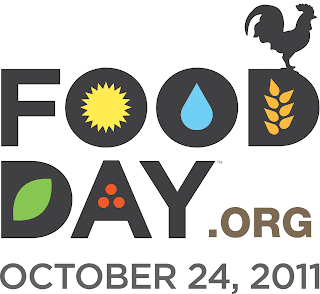Over the past couple of years Sally Sampson, founder of
ChopChop has been sending us issues of the magazine. We have been sending them out to the students and staff of the Harlem
Childrens Zone,
receiving only excellent feedback! The magazine is terrific and we thought it would be a great idea to highlight Sally on the blog.

Sally Sampson is the founder of
ChopChop, The Fun Cooking Magazine for Families.
ChopChop is a quarterly magazine and website that aims to help kids make educated choices about the food they eat.
ChopChop is published by
ChopChopKids, a Massachusetts non-profit corporation. With big time supporters such as First Lady Michelle Obama, basketball player Grant Hill, and The White House chefs featured in recent issues,
ChopChop is quickly growing toward reaching its goal of getting a copy in the hand of every child. The Harlem Children’s Zone uses
ChopChop in our after school programs. Sally answered a few questions for
HCZ about
ChopChop Magazine and healthy holiday eating.
Q: How did you come up with the idea for
ChopChop?
A: I am a cookbook writer, and had become very involved in
healthcare because my daughter has a rare chronic illness. I wanted to work in the
healthcare world, and found that I could use my skills as a cookbook writer to help fight obesity. I approached doctors with the idea of “prescribing” recipes to kids who were obese or at risk for obesity-which is one out of three American children. They welcomed the idea and the idea transformed into
ChopChop.
ChopChop aims to prevent childhood obesity by encouraging a change in behavior-a love for fresh, healthy food and cooking. We want to make cooking cool.
Q: Where is
ChopChop distributed?
A: ChopChop is primarily distributed by pediatricians but also by schools, after school and community center programs, the YMCA, Boy’s and Girl’s Clubs, food banks, kid’s cooking classes, Indian reservations, and of course, the Harlem Children’s Zone. Yearly subscriptions are also available at
chopchopmag.org.
Q: What kinds of winter recipes will be featured in the upcoming issue of
ChopChop?
A: In the winter issue, which will be released in December, we have a feature called, “Warm Soups for Cold Nights.” We feature 4 different soups that kids can make with the help of an adult and either eat right away, or freeze so they can have access to homemade soup all winter. We also have other foods to fight the cold including homemade oatmeal and biscuits. And though it’s not warm, our Eggnog Smoothie is definitely a winter treat.
Q: With all the school celebrations, parties and holiday events coming up, what’s the best way to make sure kids are still eating healthy while surrounded by so many treats?
A: We absolutely support eating treats but 1. be sure that your actual meals are healthy and hearty and 2. don't go overboard.
Q: What should our country’s food resolution be for this New Year?
A: Cook, cook and cook.
Q: Of course, cookies are typical holiday present for teachers, friends and family. Do you have any suggestions of a healthier option that kids can make for holiday gifts?
A: We actually have three “Gifts from The Kitchen” featured in the next issue. The Striped Soup Mix (recipe below), Cranberry Orange Walnut Bread, and Ranch Dressing Mix are all great alternatives to handing out sweets. There’s still the same “made from scratch” idea that comes from giving someone homemade cookies, but these three ideas are a change-up from the typical gifts.
Striped Soup MixA pot of soup is not the kind of present you can wrap—but a beautifully layered jar of homemade soup mix is! Plus, you can make a lot of presents at once to use up all those beans.
Adult: No
Hands-On Time: 30 minutes
Total Time: 30 minutes
Makes: 7 jars
WHAT YOU NEED7 1-pound bags of dried peas, beans, and lentils (pink, black, white,
lima, kidney, navy, red, or pinto beans; green, brown, or red lentils; black-eyed peas; green or yellow split peas)
7 bay leaves
7 pint-sized canning jars (or other clean, empty 2-cup jars with a lids)
Measuring cup
INSTRUCTIONS1. Carefully layer the beans in the jars, using ¼ cup of each type of bean.
2. Put 1 bay leaf in each jar, and screw on the lids.
3. Add a ribbon and a gift tag that explains how to make the soup:
Recipe Instructions (include on gift tag):Take out the bay leaf. Rinse the beans with cold water and then put them in a large pot. Cover them with fresh cold water and soak them overnight. Drain the beans, add them back into the pot with 6 cups fresh water or chicken stock, 1 14-ounce can chopped tomatoes, 1 clove chopped garlic, , and the bay leaf. Bring to a boil, then turn the heat to low and simmer gently until all the beans are tender, about 2 hours. Add salt to taste.
 The story of the four little characters, Sniff, Scurry, Hem and Haw, who make their way through a maze looking for the "Magical Cheese" that makes them happy. And once they find the Cheese, it seems like it will last forever-until one morning when everything changes. Who moved their Cheese? Will it come back? Or will they have to look for different Cheese, venturing onto strange paths, around corners they've never explored?
The story of the four little characters, Sniff, Scurry, Hem and Haw, who make their way through a maze looking for the "Magical Cheese" that makes them happy. And once they find the Cheese, it seems like it will last forever-until one morning when everything changes. Who moved their Cheese? Will it come back? Or will they have to look for different Cheese, venturing onto strange paths, around corners they've never explored?





































